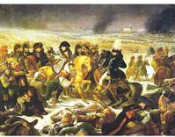
Anniversary of the decisive combat of Preussisch Eylau battle
January 26-27 (7-8 February), 1807 near the town of Preussisch Eylau in East Prussia (now the town of Bagrationovsk, Kaliningrad Oblast, Russian Federation) during the Russian-Prussian-French War 1806-1807 took place the decisive battle between the Russian and French armies.
4 (16) January Russian army under the command of General L. L. Benningsen launched an offensive from Byala west to break isolated left-flank of Napoleon's army corps, led by M. Nei and J. Bernadotte. Due to indecision of Benningsen this had not been achieved. Napoleon managed to call up from winter quarters up to 70 thousand people and took the offensive from Allenstein north to cut off the Russian army from roads communication with Russia.
January 26 (February 7) in a fierce battle on the outskirts of Eylau the rearguard led by General P. P. Bagration detered superior enemy forces, allowing the main forces of the Russian army to occupy positions on the heights north of the city.
At dawn on 27 January (8 February) the Corps of Soult made a diversionary attack against the forces of Tuchkov, and at 10 a.m. the corps of Augereau attacked the center of the Russian army, but suffered heavy losses from the fire of batteries and was repulsed to its original positions. Only the cavalry of Marshal Murat and guard Marshal J. Bessieres entering into battle saved the Corps from total defeat. At noon, the Corps of Marshal Davoust stroke the left flank of the Russian army, while the right flank was attacked by the Corps of Marshal Nei (25 thousand men on the whole). At this critical moment on the initiative of the chief of artillery of the right wing of the Russian army A .I. Kutaisov, three cavalry-artillery companies were redeployed near Auklappen. Their accurate grapeshot fire forced the French to leave Auklappen. The Russian troops of the left wing and the general reserve with the arrived Corps of Lestock in a powerful counterattack repulsed the Corps of Davout to the Klein-Zausgarten.
According to the memoirs of Denis Davidov, combatant, "there was a scramble, hitherto unseen. More than twenty thousand people on both sides plunged a triangular spike into each other. Crowds toppled. ... in the course of sixteen campaigns of my service, in the course of the entire Napoleonic Wars era, which is fairly named the epic of our age, I have never seen such carnage! For about half an hour there was not heard a single gun or rifle shot, not in the middle or around it, there was heard only some ineffable buzz of braves, who cut each other without mercy. Piles of dead bodies crumbled in fresh piles, people were falling one upon another by hundreds, so this whole part of the battlefield soon reminded a high parapet of a suddenly erected building”.
Attack of Murat's cavalry had stopped the advance of Russian troops. However, further attempts to break through the Napoleonic battle formations of the Russian Army or to surround it have failed. Late in the evening the battle ceased.
Both sides had suffered heavy losses - 26-36 thousand men each side. Battle of Preussisch Eylau was estimated by contemporaries as a strategic success of the Russian army. This is one of the few general battles in which Napoleon failed to achieve a decisive victory. Along with Pultusk battle of 1806, the battle of Preussisch Eylau entered the history of martial arts, as an example of an active defense with the use of maneuver and artillery reserves and the close interaction of components of military order.
Lit.: Давыдов Д. Воспоминание о сражении при Прейсиш-Эйлау 1807 г. января 26-го и 27-го // Русская военная проза XIX века. Л., 1989; То же [Электронный ресурс] URL: http://www.hrono.ru/sobyt/1800sob/1807preysish.php; Клаузевиц К. 1806 г., 2 изд. М., 1938; Лашук А. Наполеон. Походы и битвы. М., 2004; Леттов-Форбек О. История войны 1806 и 1807. Т. 1-4. Варшава, 1895-1898; Михайловский-Данилевский А. И. Описание второй войны императора Александра с Наполеоном в 1806 и 1807. СПб., 1846.

